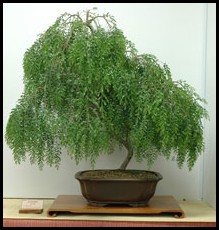Australian Native Plants as Bonsai - 2007
Catalogue Notes from the November 2007 'Australian Plants as Bonsai' exhibition held at the Australian National Botanic Gardens.
Acacia howittii The plant’s natural habitat is the southern Gippsland hills of Victoria. The common name is due to the slight stickiness of the phyllodes (leaf-like structures). In spring, it produces pale, lightly scented, light yellow balls of flowers. I acquired this as a starter plant from a Canberra nursery. The stem was thinner than a chopstick. My dream was to create a weeping style with an Australian native. The A. howittii was my logical choice as its leaves are similar in shape to the weeping willow except much smaller which is ideal for a bonsai. Trying to keep it upright was a struggle as its stem and branches were skinny and it kept falling over. Staking and wiring were the only ways to overcome this. I learnt many things about the characteristics of this plant which was invaluable to me in keeping it alive and healthy. This was my first attempt at bonsaiing an Australian native. In the autumn of 2006 it was re-potted into its present container. Both the plant and I seemed to have come a long way even though it is only 4 years since I brought it home. I am happy with the results so far and hope that it will continue to improve with the years to come. |
|
The two trees here together were originally part of a more varied group planting, exhibited in 2004, representing a corner of the Australian bush. The fast growth of the trees, however, soon necessitated the removal of several, leaving only the Allocasuarina and the Babingtonia. A nice surprise was provided by the small Allocasuarina, which grew from the roots of the large tree, early in 2006. Yet another can be seen starting on the left side. Both the Allocasuarina and the Babingtonia need frequent watering and regular fertilizing. They prefer a shady spot in summer. The Babingtonia is pruned twice a year, but the Allocasuarina’s foliage needs frequent care. The tips of the ‘needles’ need removing, especially those that branch. Also, to avoid too much of a criss-crossing of ‘needles’, it is necessary to thin them out from time to time. Neither of the two trees has ever been wired. |
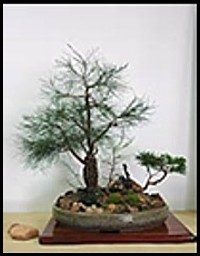 |
Allocasuarina torulosa
|
 |
The Grey Myrtle, or Ironwood, is a tall shrub or small tree, found near water courses of the coastal regions of southern NSW through to central Queensland and grows to a height of 5-10 m. It has not been widely used in bonsai, but as its many virtues become known, its use is extending. It responds very well to pruning and if heavily pruned it will shoot from very old wood. If regularly tip pruned during the growing season, it ramifies strongly and also reduces in leaf size by 70-80%. Young leaves can be a rich velvety, burgundy red, later becoming shiny dark green. The grey myrtle has small white to cream flower heads but as yet my tree has not flowered. The species can be adapted to most bonsai styles. This tree was a starter plant obtained from Roger Hinnrichsen’s Cambewarra bonsai nursery in 2005 and I’m using clip and grow techniques to develop it in a Chinese or penjing root over rock style. The tree was re-potted from a plastic training pot into a shallow round Pat Kennedy Mirkwood Forest Pottery bonsai pot. |
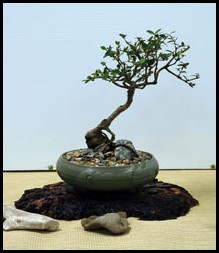 |
Banksia marginata One of two Banksia marginata purchased from a nursery in mid-2003. Provenance is suspected to be Tasmania . It was left in the original container and fed with slow release native fertiliser and pruned quite severely. The plant responded slowly, but consistently put on new growth. In autumn 2004, it was transplanted it to its current pot and has settled in well. During spring and summer of 2004-05 it commenced flowering. The flower spikes are persistent and attractive. There are currently three flower spikes, one of which appears to have aborted. This tree is quite frost hardy and is suited to the Canberra environment. |
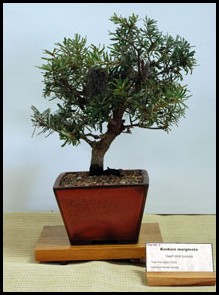 |
Callistemon 'Captain Cook' This tree was grown from an air layer taken from a garden plant in 1992. It was in a training pot for a couple of years and then transferred to a bonsai pot and styling began. It is repotted about every 2 years and cut back after flowering. It also needs some finger pinching of the tips. I vary the type of fertiliser used. |
 |
The inspiration for this Callistemon bonsai was found in the trees growing on rock bars in the Ovens River, near Myrtleford, in north east Victoria. Seedlings germinate in the hollows of the rock and roots develop, following the cracks and crevices, often clambering for some distance over the bare rock in search of reliable anchorage and sustenance in the meagre soil pockets. Regular flooding forces the majority of growth to point downstream and the trees are often elongated with sparse foliage. Many of these trees show scarred trunks and broken branches from impacts of flood borne debris. These trees show resilience and survival despite the hazardous nature of their habitat. |
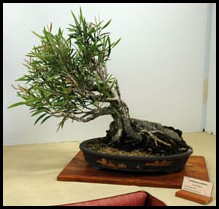 |
The origins of this tree are a bit murky as to exactly what it is and where it came from. What we know for sure is that it is a cutting-grown dwarf variety of Casuarina . |
 |
This species is typically found as a large shrub or small tree. The leaves can be up to 70 cm long but will reduce quite well when used as bonsai. The flowers are small and white. However, the most conspicuous part of the bush is the red sepals which develop and enlarge greatly after pollination. |
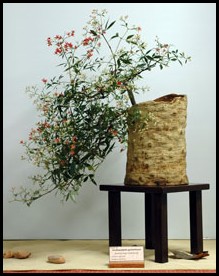 |
Nancy Stacpoole originally grew this specimen of the Victorian silver gum, also known as Buxton gum, in 1988 as a part of her extensive collection of Australian native species she was experimenting on for use as bonsai. The species has a restricted natural occurrence near Buxton and Yering in Victoria but is widely cultivated in gardens in south-east Australia where it can reach 12-15 m in height. Canberra specimens can be seen near the Faculty of Science building at the ANU. Leaf reduction is my main aim as is improving the overall shape of the tree. The old bark curling off the trunk adds age to this bonsai. |
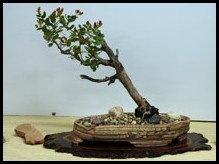 |
Found at the south Canberra dump in the Revolve section in the summer of 1995. It was in very little soil and full of disease. (mealy bug and sooty mildew). Only being new to bonsai, I thought that if this plant could survive these conditions it had potential, and it being a native, it was my opportunity to experiment with the horticulture and structure. Over the following months I removed the pests and when it showed signs of new growth I re-potted, cut back the old wood and trained a new leader. In 1999 I potted it into a bonsai pot Then in 2001 I drilled a hole from where the new leader was formed to the base, where I opened up another hole making it hollow. In late October 2003 I re-potted it into an oval, unglazed pot and in December of the same year I removed some of the rough bark to reveal a dead section of the trunk. I then cut this piece out creating another hole in the trunk. To make it a fully Australian work of art I re-potted the tree into a Pat Kennedy pot in October 2005 as seen on the ANBG web site. It was entered into the BCI competition in 2006 and received an Honourable Mention. |
 |
Eucalyptus viridis This tree was a gift from a member of the Canberra Bonsai Society in 1997. Because mallee has a lignotuber, the shape of the tree was not particularly attractive because the trunk diameter was much smaller than that of the lignotuber. It took six years for the trunk to thicken sufficiently to a stage where training as a bonsai could commence and the tree was put in the current bonsai pot. Although the tree has responded well to general plant maintenance it is still not mature. The bark will eventually be similar to that seen on box trees (E. albens), finely furrowed and shed in crumbly flakes. E. viridis is found on the western slopes of central and northern NSW and in isolated areas of northern Victoria and Queensland. The tree is frost hardy to minus 7 degrees C. |
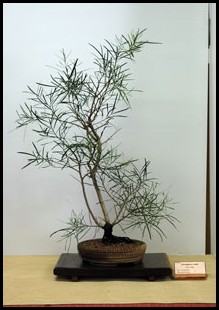 |
Eucryphia lucida |
 |
This tree was grown from seed collected in 1980. It spent about five years in a training pot before being transplanted into a bonsai container. It is trained in an upright style like ones growing in parks. Every three or four years it needs to be cut back strongly to maintain the compact growth. It grows happily in a rich, well-drained soil with plentiful water and fertiliser. It is very good for beginners as it is a very hardy plant that responds well to pruning, but it does not like frost. |
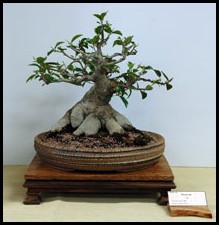 |
This bonsai was presented to me by a Japanese friend 10 years ago. The tree is over 20 years of age. The leaves are getting smaller and the roots bigger and fatter. My next task is to give the impression of a 200 year old fig growing beside Sydney Harbour. |
 |
Ficus rubiginosa 'Little Ruby' The ‘Little Ruby’ fig is a slow growing natural dwarf of the Port Jackson fig and is propagated from cuttings. This tree was first trained for bonsai last year when it was used as a demonstration tree at the 2006 Exhibition of Australian Native Plants as Bonsai. |
 |
Ficus rubiginosa |
 |
Kunzea ericoidies The sparse foliage was at the tip of the trunks. The tree was re-potted in August 2000 and all trunks were pruned to their current height. Since then continual pruning and shaping has brought the tree into its present style. The tree was potted into its bonsai pot (created by Pat Kennedy) in September 2004. This tree was displayed at the 2004 Australian Plants as Bonsai Exhibition. |
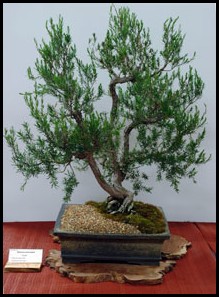 |
This native species is not actually a pine but a podocarp. It is only found in the west and south west of Tasmania, next to rivers and in boggy areas. It is a relic of Gondwana with pollen records dating back 135 million years. The timber was used for boat building as it did not rot and was not attacked by marine organisms due to its natural oils. Logging has reduced the stands to less than 10,500 hectares that are now fully protected within the Tasmanian Wilderness World Heritage Area. It grows very slowly and one tree is known to be over 4000 years old. The Huon pine is dioecious with male (pollen) and female (seed) cones on separate plants. The seeds are carried on scales and are water dispersed. |
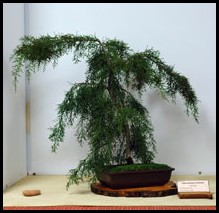 |
This semi-cascade tree with exposed roots was started from a semi hardwood cutting 10 years ago. Once established it was grown in a tall plastic pot to allow the roots to grow to a long length so they could be exposed to the dramatic effect that it is seen today. This particular variety of tea -tree is very hardy and responds very well to continual tip pruning and annual root pruning. Root pruning is best conducted during mid August to mid September. The grey-green foliage is around 2cm long so it has very good proportions for bonsai work; as do the flowers which are around 1.5cm to 2cm in diameter. They are white, appear singly on the plant, and have five petals. They appear on the plant from September through to November. Branches should be wired when young as the wood can get quite rigid in a short space of time. The rough looking pot that the tree is growing in suggests the location of a plant growing in harsh conditions. |
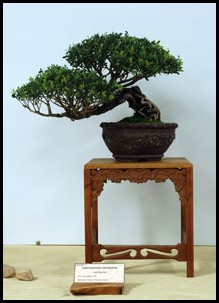 |
Leptospermum obovatum This tree is estimated to be about 100 years old. |
 |
Leptospermum ‘Pageant’ is a hybrid, strong growing with quite dense |
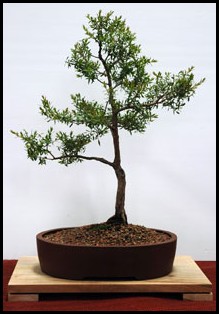 |
|
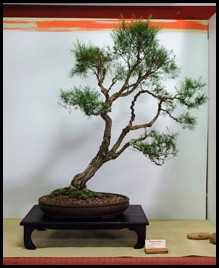 |
This plant belongs to the Myrtaceae family. Small leaves are arranged in two pairs of opposite rows forming a cross when viewed from above (hence the common name). Mauve flowers are carried in small, cylindrical spikes on short, lateral branches or at the base of leafy branches. Flowers fade to white as they age. At this time plants become covered with small, colourful spikes. This year is the first time that this tree will flower. |
 |
This tree from nursery stock was planted in the garden about twenty two years ago. It was transplanted to make way (ironically) for a bonsai display area about seven years ago and then again dug up and transferred to a large nursery pot in 2002. It has only ever produced one shoot from its somewhat shortened trunk and after re-potting last winter into its current pot, immediately dropped all its leaves. It recovered after careful nursing during the spring to what you see today - a somewhat bedraggled tree but with potential. |
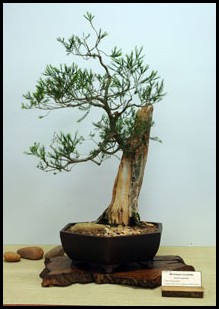 |
Melaleuca linariifolia This is a dwarf form of the parent species, which occurs in NSW and Queensland. The new growth is an attractive dark red and the tree bears fluffy white flowers in spring and summer. This tree was grown in a pot for three years with regular trimming back to develop the foliage density. It was first styled in 2006 as a demonstration tree. |
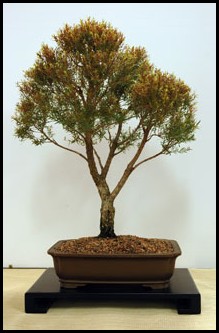 |
Melaleuca styphelioides is a hardy tree that tolerates poorly drained soils or drier conditions. It occurs naturally in NSW and Queensland and may reach heights of 10m. It has been widely used as a street tree in Melbourne and Sydney. It has creamy-white flowers in cylindrical spikes in summer. |
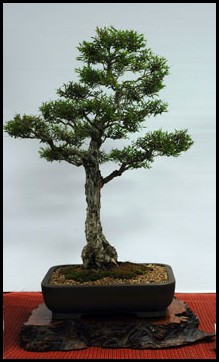 |
This 1½ m x 1½ m shrub from W.A. has small mauve flowers appearing in spring. It likes open soil and a sunny position. It is drought and frost resistant in a normal situation, i.e. garden and bush setting. However, this bonsai has been grown in a saucer of water for about 18-20 years and re-potted every 6-8 years. |
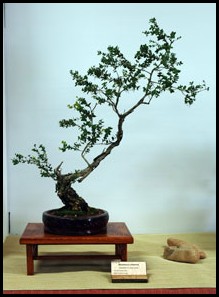 |
This is one of the very few purchased plants in my collection. Several un-styled trunks were closely knit by the roots, forming what I thought would be useful in developing a more artistic impression of an Australian rainforest.Following many years of pruning, regrowth of new basal shoots and the elimination of trunks unable to conform to desired placement, positions have recently been finalised. New foliage is in the process of emerging. This species responds to hard cut-backs and root-pruning during warmer periods without the possibility of a late frost. Drainage is also important where excess water is allowed to escape, avoiding root suffocation. Water is necessary for the rain-forest environment and it provides humidity. I can’t provide the mist. |
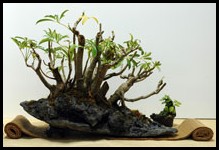 |
Syzygium luehmannii |
 |
In the wild these trees grow very large- one I saw recently on the banks of the Daintree River was more than 30 metres tall and had a similar spread with its roots dipping in the brackish water, living up to its common name ‘Water Gum’. This tree is found along rivers of the east coast of NSW and Queensland. I have owned this tree for about 12 years but this is its first showing. It was a collected tree bought from a nursery near Nowra. I was attracted to its mottled grey and creamy white bark with knobby and damaged area at the base of the trunk. The tree is growing in a blue glazed pot . As a bonsai it is quite undemanding, responding well to pruning and producing new buds on old wood. |
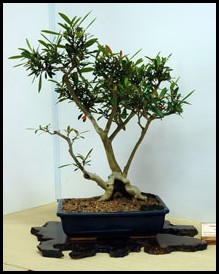 |
Photographs by Barry Brown, Graphic Designer, Australian National Botanic Gardens
![An Australian Government Initiative [logo]](/images/austgovt_brown_90px.gif)


